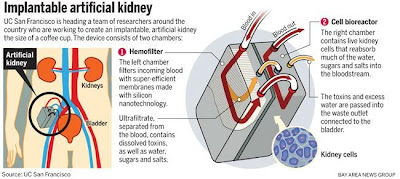Can we create an artificial/mechanical kidney to treat kidney failure?
THE FUTURE IS HERE.....WELL, ALMOST!
It has been a while since researchers started working on developing prototypes of artificial kidneys that could literally be implanted in to a human suffering from kidney failure. Theoretically, this kind of artificial kidney would replace the functions of a normal human kidney. It would flush the blood of all metabolic toxins, maintain all body electrolytes in the narrow range necessary for all life processes, produce hormones like erythropoietin (that drives the bone marrow to produce red blood cells), activate vitamin D, regulate blood pressure, etc etc. Yes, these are all some of the functions that those miracles of nature sitting in your flanks, your kidneys, are doing right now.
As you might imagine this is a tall order for any artificial implantable kidney to fulfill. Dialysis obviously doesn't even come close. It is by its very nature complicated and cumbersome. It performs, maybe, one or two of the above functions (while your nephrologist prescribes medications for the rest), and it replaces those functions for about 12 hours every week. Your kidneys meanwhile are capable of working 168 hours a week, day in and day out, hopefully for your entire life!
It has been well over half-a-century since dialysis, as we know it today, was invented. Today, patients and physicians are rightfully waiting for a modern, efficient, less cumbersome option. Well, fortunately, we do have some potential solutions on the horizon.
The first technology that has shown promise is the idea of essentially miniaturizing the dialysis machine itself. That is, create filters that are much more efficient than what you see on a conventional hemodialyzer. This should allow, in principle, to shrink the dialyzer to a size small enough that it can be implanted in a patient. Throw in a few bioactive kidney cells with the dialyzer to replace the other kidney functions, and hopefully, you should have a prototype small enough, and effective enough, to replace the failed kidneys' function. This is what researchers at University of California at San Francisco, lead by Dr Shuvo Roy, are trying to achieve (see video below). The implantable kidney itself is called the iRAD (Implantable Renal Assist Device). The project has been considered promising enough by the FDA to be put on its "fast-track" program, which will help expedite funding and approvals.
The obvious question in most people's mind is: how soon can I have an iRAD, and "cut the cord' from dialysis. Well, this could still take years since the clinical trials are only expected to start in 2021, after which if everything goes as expected, it could be another few years of safety trials. An optimistic duration that we could be looking at is about 5-8 years. Till then, dialysis or transplantation are the only available options that we have for treating people with kidney failure. I have talked about another way of growing an artificial kidney using human cells in another post.
Veeraish Chauhan, MD, FACP, FASN
Nephrologist
Sarasota/Bradenton, FL



Comments
Post a Comment